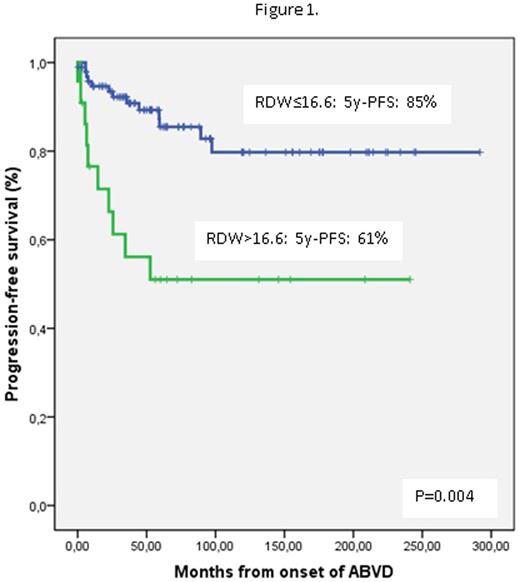Abstract
Red cell distribution width (RDW) is an indicator of the variability in the size of circulating erythrocytes (anisocytosis); different conditions can increase the RDW levels; such as hemolysis, ineffective erythropoiesis and blood transfusions. Recently, different studies have shown an association between increased levels of RDW and inflammation in different diseases, being proposed as a surrogate marker of inflammation and astrong predictor of adverse outcome. The proposed mechanism of this association departs from the finding that Inflammatory cytokines like TNFand IL-6 (part of the classic inflammatory cascade), have been found to inhibit erythropoietin-induced erythrocyte maturation, which is reflected in the RDW increase.
Hodgkin lymphoma (HL) is a B cell neoplasm which originates in the germinal or post-germinal center B cells and is characterized by the presence of clonal malignantHodgkin/Reed-Sternbergcells (HRS) in an inflammatory background. The presence of autocrine or paracrine cytokines signaling loops drive proliferation and survival of HRS cells, making HL a lymphoma where the inflammatory status is important. We aim to evaluate the prognostic role of RDW levels in HL patients at diagnosis.
METHODS
We retrospectively evaluated 119 patients with HL homogenously treated in frontline with ABVD from 2001 to 2015 in the Son Espases University Hospital. To avoid selection bias patients were obtained from Pharmacy and Pathology Departments registries. Main clinical and prognostic factors at diagnosis were obtained from medical records. Cheson criteria were used for response assessment. The RDW was collected from the hemogram at diagnosis. The IBM SPSS STADISTICS program was used for all statistical analyses. PFS (time to progression/relapse) and overall survival (OS) (time to death) were measured from the date of ABVD onset, and were estimated according to the Kaplan-Meier method. We performed the comparisons between those interest variables with the log-rank test. A comparison between categorical variables was made with the chi-square of Fisher's exact test, as appropriate. All reported P-values were two-sided, and statistical significance was defined at P<0.05. For selecting cutoff values in RDW we used ROC curves.
RESULTS:
Main characteristics of patients were as follows: median age was 37 (15-75) years, 61% were males, 13% had ECOG PS>1, 47% advanced III-IV Ann Arbor (AA) stage, 42% B-symptoms and 29% IPS>2 Median RDW was14.1 (11-23.9).Using ROC curves we selected the cutoff 16.6 for relapse/progression event. We evaluated the association of increased RDW with main prognostic factors at diagnosis. RDW >16.6 at diagnosis was associated with a worse ECOG PS, a more advanced AA stage, higher incidence of B symptoms, IPS>2, higher Erythrocyte sedimentation rate (ESR) and unfavorable lymphocyte/monocyte rate (LMR) (Table 1). Patients with RDW>16.6 were associated with worse responses compared to those with RDW≤16.6: 29% versus 6% of stable/progressive disease and lower complete or partial responses: 67% and 5% versus 93% and 1%, respectively (p=0.004).
Univariate survival analysis is shown in Table 2. Age, ECOG PS, AA stage, IPS, LMR and RDW were related to PFS. Age, ECOG PS, IPS and LMR were associated with OS. Multivariate analysis showed age>60 years (HR 7.66; p=0.002), RDW>16.6 (HR=3.41; p=0.005) and advanced AA stage (HR=2.55;p=0.044) as independently associated to worse PFS (Figure 1) while only age>60 years (HR=11.5; p<0.001) and ECOG PS>1 (HR=4.15; p=0.008) independently influenced a worse OS.
CONCLUSION:
Higher RDW at diagnosis was related with more aggressive and advanced disease in HL and lower response rates, probably reflecting a higher inflammatory activity of the lymphoma and its microenvironment. RDW>16.6 was independently associated with a worse PFS.
No relevant conflicts of interest to declare.
Author notes
Asterisk with author names denotes non-ASH members.




This feature is available to Subscribers Only
Sign In or Create an Account Close Modal